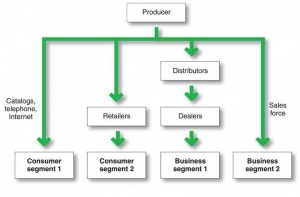Distribution Channels for Services: Big Ideas, Big Payoffs
I talk about the un-glamorous but important topic of distribution channels. It’s one of the “4 Ps” (“placement”), but many marketers and smaller companies don’t think about it as often as they should. It’s potentially the most important strategy in your arsenal.
People ask me all the time “What is a ‘Distribution Channel’?”
A distribution channel is a chain of businesses or intermediaries through which a good or service passes until it reaches the end consumer. It can include Sales Representatives or Sales Channels (which I discuss below to avoid confusion) wholesalers, retailers, distributors and even the internet. Channels are broken into direct and indirect forms: A direct channel allows the consumer to buy the good from the manufacturer, and an indirect channel allows the consumer to buy the good from a wholesaler or retailer.
A distribution channel is the path by which all goods and services must travel to arrive at the intended consumer. Conversely, it also describes the pathway payments make from the end consumer to the original vendor. Distribution channels can be short or long and depend on the amount of intermediaries required to deliver a product or service.
However, goods and services sometimes pass to consumers through multiple channels — a combination of short and long. While increasing the number of ways a consumer can find a good can increase sales, it can also create a complex system that sometimes makes distribution management difficult. In addition, the longer the distribution channel, the less profit a manufacturer might get from a sale because each intermediary charges for its service.
When I sell a physical product, it’s easy to keep distribution strategy and channels at the top of the priority list. I am usually part of a sales team or lead a direct sales team, or a network of resellers & VARs, a retail presence, a catalog and/or an e-commerce website. I have done it all. I prefer to sell. I like meeting new people and solving company problems.
But what about distribution channels for services?
Most services firms in the U.S. are small businesses under $1 million in revenue. Many are caught in the E-Myth — the founders are working in the business with little time to work on the business. And when you’re stuck in the E-Myth, it’s tough to find time to lead your company to hyper-growth.
For these services businesses, a new distribution channel can be just the ticket. The opportunities may not be obvious, but they’re there when you apply your creativity.
Strategies for Building Distribution Channels for Services Companies
As you think about expanding your distribution channels, focus on your typical customers. Here are some questions to get you started:

1. List other products or services your customers use.
- What problem are your customers trying to solve when they buy from you?
- Are there complementary services or products that come before or after they join you?
- What else may be on your decision maker’s plate at the time they buy from you?
2. Find organizations who already have access to your prospects. Think broadly about
- Media they consume (online content, podcasts, industry publications, newspapers, etc.)
- Services they subscribe to
- Consultants or vendors they work with
- Companies they buy from regularly
- Organizations they belong to
- Events they attend
The organizations you’ve listed are potential distribution partners or channels for you!
Examples of Services Distribution
Here are a few case studies to inspire you as well.
Strategy #1: Buck tradition
Logoworks ( now HP) uses a non-traditional distribution strategy for their industry with enormous success.
There are thousands of graphic designers & firms in every city. They compete for the same business and it’s difficult to gain leverage over their time.
Instead of setting up shop and knocking on local doors, Logoworks distributes their design services via the internet. They use search engine marketing (both organic and paid search), online ad campaigns and ongoing online publicity to gain clients all over the world. It’s possible for them because they also distribute their product – logo designs – via the web.
This distribution strategy also gives them a more compelling value proposition: operational efficiency. By using a pool of virtual designers, Logoworks is able to provide clients multiple design options at a much lower cost than a traditional firm.
Their internet distribution model has been extremely successful, and this spring, H-P acquired the company. Why? H-P wants to use the Logoworks offering as a value-add to their small-business customers.
That’s a smart distribution strategy.
Strategy #2: Hang out with your customers
Here’s another distribution option: partner with a company whose customers need your service.
Let’s say you’re launching a new tech support service. You could knock on doors and market your services locally. Or you could raise millions and spend it on marketing, physical locations and overhead.
Instead, Geek Squad partnered with Best Buy to offer their services right inside their stores. When Best Buy sells a computer, customers know that Geek Squad can service it if they have any problems. They even promote the Geek Squad brand in the parking lot.
This partnership was so successful that Best Buy acquired Geek Squad in 2002.
Companies that create software widgets can find great success partnering with bigger software companies that have a critical mass of users.
Jigsaw founders Jim Fowler and Garth Mouton were a pair of high-tech sales pros frustrated with the amount of time they spent searching for contact information. So they created Jigsaw, an online directory of more than five million business cards.
Now they needed access to salespeople, so they joined Salesforce.com’s App Exchange program, offering their service to any Salesforce user.
Salesforce.com is a major distribution channel for Jigsaw, giving them access to tens of thousands of potential customers.
They’re now one of the 10 top App Exchange applications.
Home Depot
How about a non-technical case study? Consider all of the vendors who provide service via Home Depot.
When you hand over your credit card for granite countertops, flooring or a new garage door, you don’t have to DIY. Home Depot will sell you installation services if you need them, but they don’t provide those services directly.
Instead, they have teams of subcontractors in each market to perform those jobs. Home Depot is a distribution partner for those contractors, giving them access to a large pool of customers who need their services right now.
Get Serious About Distribution Channels!
Developing a new distribution strategy, then creating and managing the program can be tough work – particularly if you’re a service company with limited resources.
But if you’re looking for new ways to gain leverage and build your business, take a serious look at your distribution strategy. You can start small with a single partnership and work up from there.
If you’d like more hands-on guidance, I have guided templates to walk you through the steps of building your distribution channels for services as well as distribution channel planning and through marketing planning and management consulting evaluating your integrated processes by; refine your brand strategy, write a marketing plan, calculate marketing ROI, design a marketing campaign, expand distribution, create a product launch plan, improve your content marketing, learn strategic marketing
I would like to elaborate on the difference between a sales channel and a distribution channel. Why? Because some people are both.
Sales channels are the means used to convert leads into customers.
Distribution channels are the means used to fulfill your obligation to supply a product or service.
But the confusion arises because the same organisation may be both a sales channel and a distribution channel.
To illustrate, imagine you own a brand of chocolate bars (let’s call it ‘Pluto’, because since water was discovered on Mars marketeers may be in a huff). Your customers are primarily grocery chains, distributors and wholesalers, and perhaps a long tail of smaller independent confectioneries and individuals.
Sales orders come from all these parties. They may come through your own salespeople going out to visit and negotiate with them, or via phone calls, or via an online wholesale storefront. These are your primary direct sales channels. But you may also sell through storefronts not owned by you. These could be large marketplaces (both brick and mortar, as well as online marketplaces like Alibaba or Amazon). These are indirect sales channels.
But you will not be able to reach the entire market – and in any case even if you could, dealing with the large numbers of small customers individually is very inefficient. So you will use the middlemen mentioned earlier.
In order for your product to reach the widest distribution, and for you to deal with fewer customers, you will actively deal with wholesalers and dealers. They will buy your product in large quantities at low margins, and in turn sell them to the end consumer. You will also likely have some means of reaching certain large customers (e.g. the grocery chains) yourself. Taken together, these are your distribution channels.
Now you may see the confusion – the same wholesaler that is one of your sales channel, may also be your distribution channel. They are your sales channel in that they interact with your sales people, and give you sales. But they are also your means to distribute your product.
What do you think about your distribution channels? Is your strategic plan helping you expand your reach and grow revenue? If you would like to comment on this article or learn more about my consulting project management work, please visit me at my personal website www.tonycrilly.com

10 Crilly Management Consulting Case Studies
Please, share your thoughts in the comment area below.





